Photovoltaic Solar Panel Basics
Before seriously deciding to order a photovoltaic (PV) solar system for my home, I did some serious on-line research of the current status of solar, the currently available equipment, and the several basic configurations you can use to set up the solar system. When I finished the major portion of this study, I thought possibly what I had learned might be of interest to others, so I tried to document it here. I hope you find it interesting and informative.

Several houses with solar panels on the roof. The house on the left is the location of the "Solar open house" where I started looking
at current day solar installations.
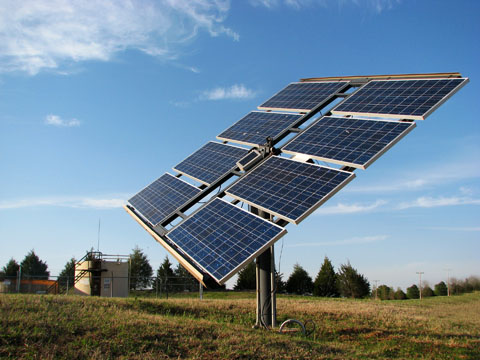
Panels can also be mounted on poles.
Types of Solar System
There are three basic types of residential photovoltaic solar systems:
- Grid-tied systems
- Off-grid systems
- Battery backed up grid-tied systems
In the following discussions I often refer to a single inverter. This is for simplicity as large systems may have two or even more inverters just to handle the load, and in the case of micro-inverters, as you will see, there is one per panel.
Grid-tied Systems
These systems consist of a number of solar panels feeding an inverter. The inverter is connected directly to the electric utility lines (through the required meters and switches of course). For most systems the long term usage should balance out to near zero, although often systems are intentionally designed only offset part of the electric bill. Other times systems are intentionally designed over size to always sell some power to the utility company. Power companies usually limit how much oversize you may build a system and still have them buy the excess power.
In Prescott, Arizona we have what is called net metering. When the household is using more electricity than the panels produce (at night, cloudy days, high usage, etc.), the utility company supplies the additional electricity as needed, Typically during the middle of the day when the panels supply more electricity than the household needs, the electric meter actually runs backwards and the panels supply electricity to the utility company. The way net metering works is that each month your electrical balance may be positive or negative. When it is negative, you pay for that power as you normally would, but only for the amount you failed to produce yourself. When it is positive you get full credit for the excess power supplied to apply to future bills. At the end of the year if you have a positive balance, the power company will buy the excess power from you at wholesale rates. NOTE: I have just described the situation with our power company here in Arizona. I understand that different areas have different ways of handling the billing. Some may not be as beneficial to the user. As you will see later in the main write-up, our power company is trying to change the rules to make solar here much less attractive for us users and make a lot more money for the utility.
A disappointing fact I discovered in my studies is that by law, if the power from the utility goes off, the solar system must automatically shut down. This is for the safety of personnel trouble shooting the dead lines. I had hoped the solar would provide me power during a daytime power outage by the utility company, although that is actually a very rare occurance.

This diagram shows a standard grid-tied system with all the meters, disconnect switches,
etc. Normally there will also be a combiner box to join more than one string of panels.
All the systems include most of these extra elements, but for simplicity's sake, in all the
remaining diagrams, I show only the active components.
Off-grid Systems
These systems are primarily used for houses located too far from the electrical
utilities to make it affordable to connect
to them. The systems consist of sufficient roof top or pole
mounted panels to supply near the peak electrical needs of the
family. The
panels charge a large battery bank that stores enough power to operate
overnight, through cloudy days, and for short term peak loads.
The batteries then feed an
inverter to provide normal household AC current. Some more rustic
installations just operate from the battery low voltage DC. Many
times a generator is part of the system to provide for extended cloudy
periods or to merely reduce the size of the battery bank.
Occasionally this off-grid type of system is used in populated areas
served by the utility company just to avoid having to connect to
them. The off-grid systems tend to be quite expensive due to the
need for higher panel capacity and the large battery bank.
Grid tied
systems are more economical than off-grid ones as the panels need only
supply the average amount of power used during the course of a year. Off grid systems need
to supply near the maximum level used at any one time, and need to have a large battery bank.
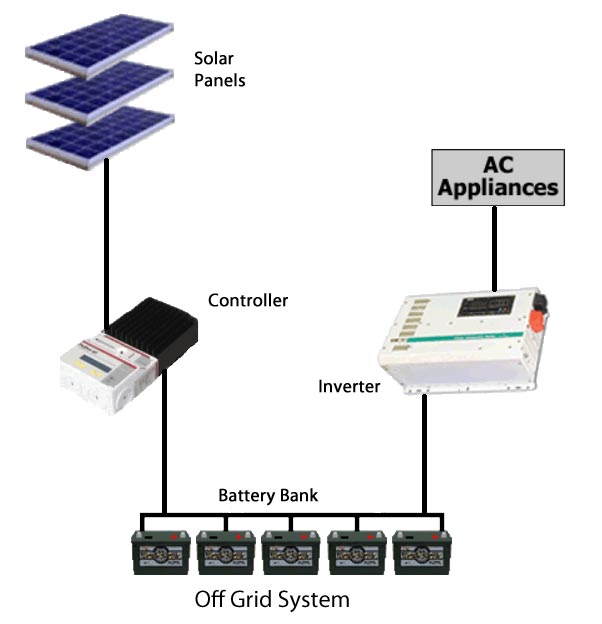
Battery Backed up Grid-tied Systems
These systems are a combination of the two previous systems. They are a full grid-tied system with the added feature of a battery backup system to carry the household load during power company outages. It is more economical than the off grid systems, as the panel capacity still only needs to cover the average over a year and the battery capacity need not be as high. The added advantage of being able to bridge the blackouts is still expensive. You need to buy, maintain, and replace the batteries every 5 to 8 years, and that is expensive. As a result, it is mostly found in areas and countries where the power is unreliable.
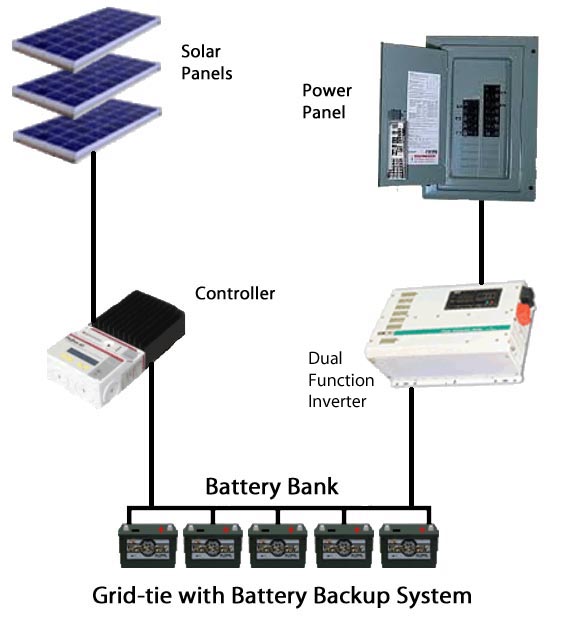
For my use, the grid-tied system is the only one I would consider. The grid provides an unlimited virtual battery to equalize your usage at a very high efficiency. An off grid system must provide for the maximum load during the heaviest usage times. Any excess power generated during lower usage times goes to charging the batteries. Once the batteries are fully charged, any excess power is wasted. You cannot balance the summer and winter seasons. With grid-tied systems that is exactly what you do. The utility company "battery" is never fully charged. You can just keep sending them your excess power and then use it months later when you need it. The efficiencies of grid-tied power run around 95 to 96% from the DC generated to the AC either used or sent to the power company. Charging and discharging a battery bank is done with an average efficiency of about 85%, but can vary widely.
Types of Grid-tied Systems
There are several variations of grid-tied systems, three of which I have researched and describe here:
- The conventional inverter system,
- The micro-inverter system
- The power optimizer system.
The conventional inverter system consists of the solar panels series connected in strings of around 10 to 15 panels per string. The various strings are combined and routed to a single large inverter which converts the several hundred volts DC to 120/240 volts AC compatible with the power in your home. The first stage of the inverter will adjust the voltage and resultant currents of the panel bank as a whole to maximize the electrical output. This is called maximum power point tracking, or MPPT. The second stage takes this adjusted DC power and converts it to 120/240 volt AC power. This power is connected through the proper protective devices to the normal household circuits and to the incoming power company feed.
This configuration is the most economical to buy and install, but has some drawbacks. In a series string of panels, the output of all the panels is limited by the weakest one in the string. Normally this is not a major problem as new panels are fairly well matched. However if one panel is partially shaded by an errant tree branch, leaves, or other debris, the entire string of panels suffers. Also an electrical failure on any one panel will disable the total string. As the average home system will consist of one to three series strings of panels, the loss of power of a single panel will severely limit the output of the total system! It also routes all the power through a single large inverter. This creates a single point of failure. If the inverter goes out, the total system stops working. Large inverters also seem to be fairly short lived at about 10 to 12 years.
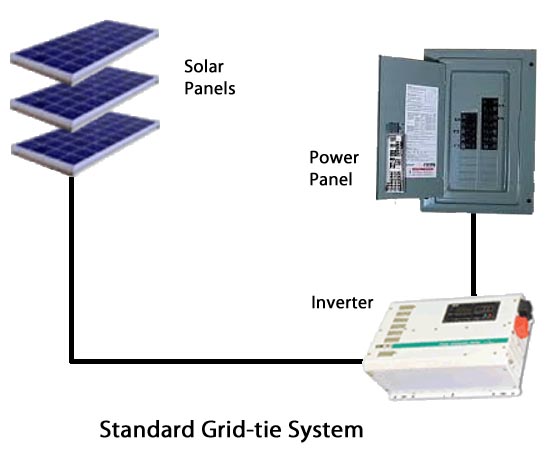
The micro-inverter system very effectively solves this "weakest link" problem. Each panel in the system has a small inverter attached right at the panel. The inverters each adjust the panel output for the maximum power (MPPT) and produce 120/240 volt outputs which are all connected together and fed down to the power panel, and connected there much like any other system.
The advantage of this system is that each panel stands on its own. If some panels are at times in the shade, the power from those panels is lost, but no other panels are affected. If the panels receive different light amounts such as being mounted on different roof surfaces, each panel is optimized for its own conditions. The power produced is typically higher than for a conventional system using identical panels. All the roof top wiring is AC. This makes the installation somewhat safer as high voltage DC power is much more deadly than AC in case of accidental human contact.

The power optimizer system is a variation of the micro-inverter system. Each panel has a module attached called a power optimizer. This is like the first half of a micro-inverter. It performs the MPPT optimizing functions causing each panel to operate at its maximum, but still outputs a DC voltage. The panels are wired in series strings just like the conventional systems, but the optimizers prevent a loss of power from a single panel from affecting any others in the strings. The design of the system also allows the strings to be "unbalanced". There may be more panels in one string than another, and the panels may be of different types. The optimizers adjust their output to balance the unequal strings. The output of these series strings is sent to a central inverter. The inverter is typically a single inverter but is simpler than the normal solar inverter, as it has no need to perform the MPPT functions. It just change a fixed DC voltage to the 120/240 volt AC power.
There are pros and cons to this system as compared to true micro-inverters. It is slightly less expensive and it should dissipate slightly less heat (on the roof) than a micro-inverter. On the down side, the optimizer typically uses a single inverter. This provides a single-point-of-failure. If this inverter fails, the entire system goes down. A micro-inverter failure will only lose the output from a single panel. The life of the large inverters (and the warranties) seems to be about 10 to 12 years as opposed to the micro-inverters which are warranted for (and hopefully last for) 25 to 30 years.
I have seen many reports of excellent performance from micro-inverters, but have not seen examples of how well power optimizers actually work. The wiring is still high voltage DC, but this is turned off when connection to the grid is broken.
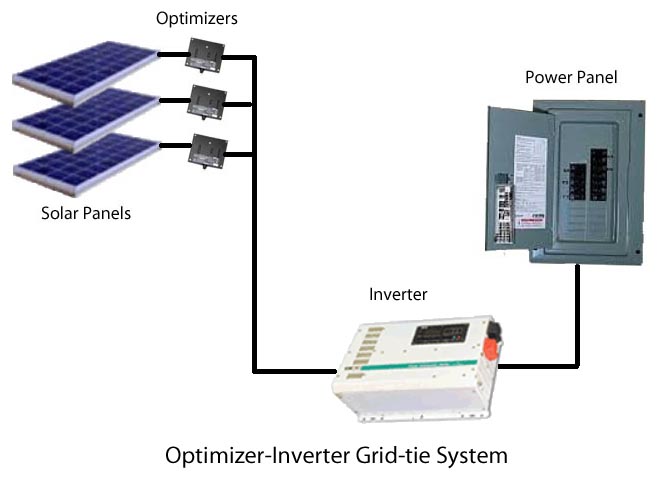
I would be happy with either a micro-inverter or an optimizer system. Each system provides module by module monitoring. I think the pros and cons pretty well balance each other, although the overwhelming popularity of micro-inverters over optimizers may be for a reason.
Safety Concerns
The wiring on the roof and down to the inverter in a conventional system is all high voltage DC which is much more dangerous to human contact than comparable AC voltages. As many panels are wired in series, voltages can reach 300 to 600 volts. It doesn't matter what disconnect switches are turned off, this voltage still occurs before the switches if there is any daylight. This is an immense danger to fireman and emergency workers if they have to work on the roof. DC voltages are also subject to arcing that will not extinguish itself as an AC arc will.
These problems are minimized with optimizer systems and eliminated with micro-inverters.
An optimizer system is still a series wired, high voltage DC system, but the optimizers reduce the voltage output to near zero when the AC grid power is off. This makes the system safe for emergency workers, but not necessarily to the installers and troubleshooters who may work with the system energized. Arcing is still a potential problem.
A micro-inverter system never has DC voltages higher than that of a single panel, typically around 25 to 30 volts under load (as set by the MPPT) and about 35 to 40 volts open circuit. All the roof wiring is 120/240 volts AC and there is no voltage present on the roof wiring when the AC grid power is off. This makes the system safe for emergency workers and safer for the installers and repair personnel.
Monitoring
Today most grid-tied systems offer remote monitoring. By including an optional (sometimes it is standard) module which attaches to your home broadband Internet connection, you and the supplying company can monitor the performance of your solar system in near real time. For a standard system, this monitoring looks only at the combined performance of your panels. In a micro-inverter or a power optimizer system, the monitoring displays performance data for every individual panel, typically receiving the data every 5 minutes. This can be of immense help trying to diagnose a subtle system problem. The Internet monitoring software provided is usually very comprehensive, showing present output of each panel and the system as a whole, the daily total output for each panel and as a whole, historical records of total output, averages, etc. They usually also show environmental factors, such as tons of carbon avoided, trees saved, and the number of houses your output would have powered for a day.
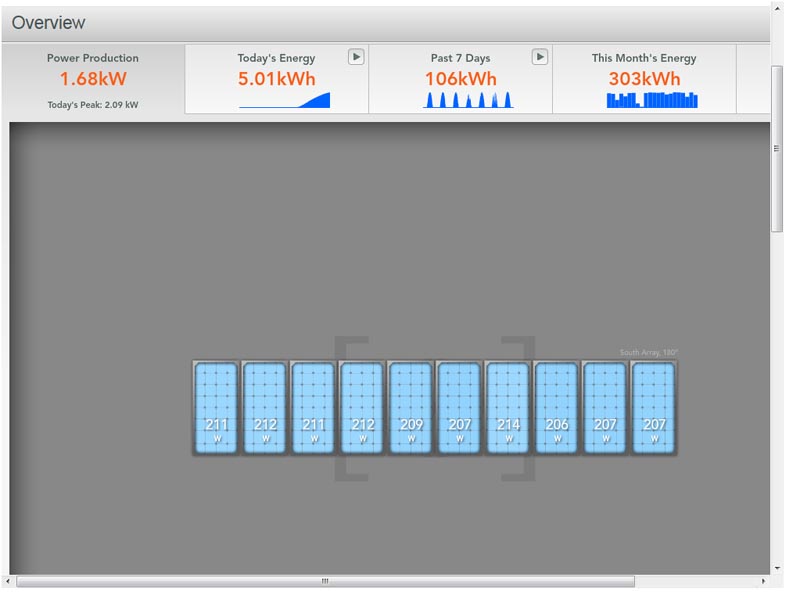
Our church installed 10 solar panels with micro-inverters in late 2012 to partially offset their power usage.
This is a view from their monitoring site showing the present power output of each panel (when this image was
captured). Clicking the other tabs at the top show total energy generated today, the last 7 days of
energy, and the energy so far this month. All are shown for each panel. (Power is the unit for what
is currently being produced, i.e. watts or kW; energy is the summation over time of this power,
i.e. watt-hrs or kWh and is what the utility company charges you for.)
You can also pull up graphs of a time-line showing system output for anywhere from the last 24 hours to
the lifetime of the system. Of course the displays will vary by the manufacturer of the systems, but all
seem to be very similar.
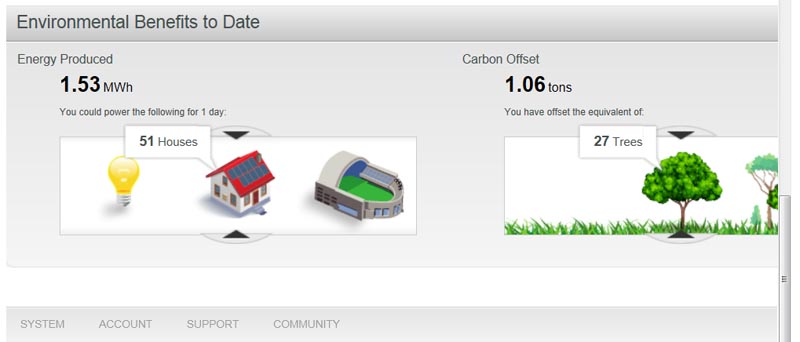
For those who are interested in the environmental impact of their system, this type of summary is available.
Incentives
A number of incentives are offered by federal, state, and power companies for installing solar power. These vary by state and power company. In my area currently all three are offered. They consist of:
- A federal tax credit of 30% of the total installed cost
- An Arizona state tax credit of 25%, but limited to a maximum of $1000
- a rebate of $0.10 per installed watt from our local power company, APS
If you lease a system, the company leasing it to you takes all the government incentives. In fact, the incentives for a commercial company are better than for an individual, so they get a higher percentage of the system cost back than you or I could personally.
If you purchase a system, you are then eligible for all these incentives, which can significantly reduce your total expense, at the cost of more complex tax filing and delayed payments.
In addition to the Arizona tax credit, the state offers two additional incentives:
- they will not raise your property tax assessment when you add solar power to your home
- the purchase of a solar system is exempt from sales tax
Summary
If you plan on installing solar electric in your home, you (or your installer) need to carefully evaluate your usage, your location, and suitable panel mounting locations that face south or even east or west, have no shade and are structurally adequate. You need to carefully evaluate the incentives and verify that you can truly use them. For the governmental tax credits, you must pay enough tax to use the incentives within the time alloted. The Federal government appears to allow you to carry over any unused credits indefinitely, although the correct forms may be hard to get after the program expires in 2016; the state of Arizona gives you five years to carry over the credits. Check to verify what incentives and periods your state offers. You then need to decide on the type system which will best meet your requirements and your budget. I hope that the above descriptions will help you make these decisions.
To continue on to my personal experiences adding solar to my home, CLICK HERE